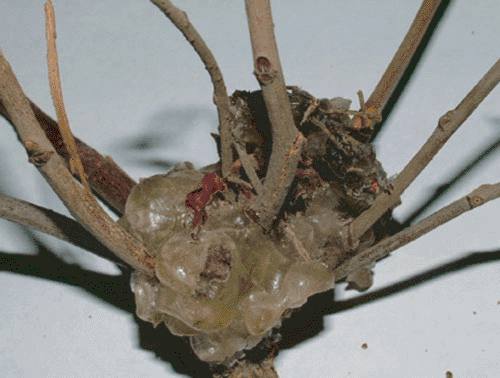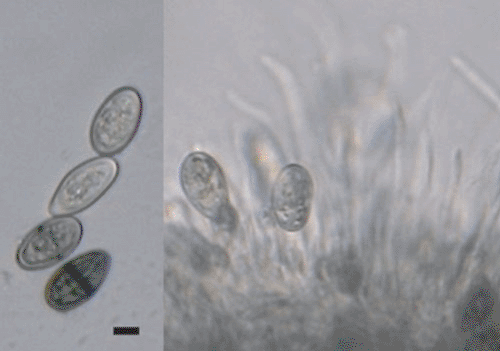First record of Jatropha podagrica gummosis caused by Botryodiplodia theobromae in China
G. Fu A B , S. L. Huang A C , J. G. Wei B , G. Q. Yuan B , J. G. Ren A , W. H. Yan A and Z. L. Cen AA Plant Protection Institute, Guangxi Academy of Agricultural Sciences, Nanning, Guangxi 530007, China.
B College of Agriculture, Guangxi University, Nanning, Guangxi 530005, China.
C Corresponding author. Email: silianghuang@126.com
Australasian Plant Disease Notes 2(1) 75-76 https://doi.org/10.1071/DN07030
Submitted: 11 April 2007 Accepted: 26 April 2007 Published: 10 May 2007
Abstract
Jatropha podagrica gummosis, caused by Botryodiplodia theobromae, was found for the first time in China at Pearl Square in Beihai City, Guangxi province in 2005. The fungus was isolated and the pathogenicity confirmed. This is the first record of the pathogen on J. podagrica in China.
Jatropha podagrica (Euphorbiaceae) was used as a traditional folk medicine against fever, as a diuretic, a mouthwash for jaundice, for gonorrhoea, as well as a purgative in West Africa and some parts of Europe. It is the source of antimicrobial materials against many microorganisms (Odebiyi 1981, 1986; Van den Berg et al. 1996) and was imported as an ornamental plant in the south of China because of its specific artistic modelling capabilities. J. podagrica gummosis was found in 2005 at Pearl Square of Beihai City, Guangxi, China. A study on the identification and characterisation of the causal organism of the disease was carried out.
Gummosis was frequently observed at the ramose sites from which branches were ramified. Opalescent or brownish-yellow mucus was secreted from the infected site, which then turned dry and adhered to the trunk and branch and looked like amber. Many black dots (stroma) were found beneath the ‘amber’ (Fig. 1). Pathogenicity tests of the isolated fungus were carried out as follows. The fungus was incubated on potato dextrose agar plates (PDA) at 28°C for 6 days. Mycelial discs (9 mm in diameter) were removed from the colony and plugged into freshly wounded sites of healthy branches of J. podagrica. The inoculated sites were sealed with an adhesive tape to maintain high humidity. Disease symptoms developed 14 days after inoculation. A fungus with the same morphological characteristics as the inoculated fungus could be reisolated from the diseased area of the inoculated plant.

|
The pathogenic fungus produced stroma on PDA plates. Colonies were grey-brown to black with dense aerial mycelia on the media. Pycnidia were separate or aggregated, dark brown, thick- or thin-walled. Conidiophores formed from cells lining the inner wall of the pycnidium were hyaline, smooth, cylindrical to subobpyriform, determinate or indeterminate. Conidia were oblong, straight, hyaline and, at first, aseptate. Then they became dark brown, produced one septum with longitudinal striations, broadly rounded at the apex, truncate at the base and 22–29 × 11–15 µm (av. 26.2 × 14.3 µm) in size. Paraphyses were hyaline, cylindrical, septate and up to 50 µm long (Fig. 2). The fungus was identified as Botryodiplodia theobromae (anamorph: Botryosphaeria rhodina) based on morphological characteristics, which agreed with that of B. theobromae (Von Arx 1974). The rDNA sequence of the ITS of the pathogen (GenBank accession number: EF110920) completely matched the ITS sequence of B. rhodina registered in GenBank. A dried culture has been deposited in the Fungal Collection of Guangxi Academy of Agricultural Sciences.

|
The growth temperature range of the fungus was 7–40°C with 28°C the optimum. Growth occurred over the range pH 2.5 to 11.0 with pH 6.5 the optimum. PDA and potato sucrose agar media were more suitable for its vegetative growth than eight other media: beef extract agar, potato agar, Gause’s synthetic agar, oat agar, maize agar, soybean agar, soluble starch agar and water agar. Nitrogen utilisation tests showed that peptone was better for growth than L-proline, DL-asparagine, L-cystine, ammonium nitrate, ammonium chloride, L-cysteine and L-lysine. Several carbon sources including dextrose, sucrose, D-mannose and maltose were well utilised for mycelial growth. D-galactose, sorbitol, soluble starch, glycerine, xylose, gelose and D-arabinose were not well utilised as carbon sources for growth. The sensitivity of the pathogen to 13 commercial fungicides was tested. The fungicides were separately added in a molten PDA medium at the mid-concentrations recommended by their makers for field applications against common fungal plant diseases. The results indicated that the pathogen was highly sensitive to prochloraz (333.33 mg/kg), carbendazim (800 mg/kg), thiram (1000 mg/kg), flusilazole (44.44 mg/kg), propiconazole (375 mg/kg), thiophanate-methyl (700 mg/kg) and mancozeb (1142.86 mg/kg) in which the growth inhibition rates were higher than 90%, and low to chlorothalonil (1400 mg/kg), dimethomorph (538.46 mg/kg), azoxystrobin (250 mg/kg), cupric hydroxide (538 mg/kg), triadimefon (1000 mg/kg) and cuprous oxide (492.57 mg/kg), in which the growth inhibition rates were lower than 75%.
This fungus has been reported as a pathogen of more than 500 plant species (Punithalingam 1976) and causes symptoms including canker, dieback, damping-off, wilt, root rot, collar rot and fruit rots. Although distributed worldwide, it is mainly confined in an area between 40°N to 40°S. This is the first record of B. theobromae on Jatropha podagrica in China.
Odebiyi OO
(1981) Antibacterial property of tetramethylpyrazine from the stem of Jatropha podagrica. Planta Medica 38, 144–146.

Odebiyi OO
(1986) Steroids and flavonoids from Jatropha podagrica stem bark. Fitoterapia 56, 302–303.

Van den Berg AJJ,
Horsten SFAJ,
Kettenes BJJ,
Beukelman CJ,
Kroes BH,
Leeflang BR, Labadie RP
(1996) Podacycline A and B, two cyclic peptides in the latex of Jatropha podagrica. Phytochemistry 42, 129–133.
| Crossref | GoogleScholarGoogle Scholar | PubMed |



